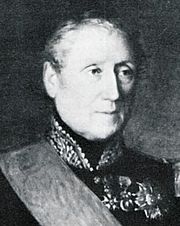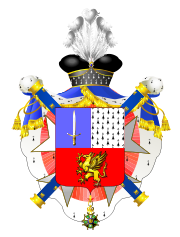
Philippe Antoine d'Ornano
Encyclopedia

Comte
Comte is a title of Catalan, Occitan and French nobility. In the English language, the title is equivalent to count, a rank in several European nobilities. The corresponding rank in England is earl...
d'Ornano (January 17, 1784 - October 13, 1863) was a French
France
The French Republic , The French Republic , The French Republic , (commonly known as France , is a unitary semi-presidential republic in Western Europe with several overseas territories and islands located on other continents and in the Indian, Pacific, and Atlantic oceans. Metropolitan France...
soldier and political figure who rose to the rank of Marshal of France
Marshal of France
The Marshal of France is a military distinction in contemporary France, not a military rank. It is granted to generals for exceptional achievements...
. He was made Count
Count
A count or countess is an aristocratic nobleman in European countries. The word count came into English from the French comte, itself from Latin comes—in its accusative comitem—meaning "companion", and later "companion of the emperor, delegate of the emperor". The adjective form of the word is...
d'Ornano of the French Empire
First French Empire
The First French Empire , also known as the Greater French Empire or Napoleonic Empire, was the empire of Napoleon I of France...
in 1808. He was born a son of Lodovico Antonio Ornano and Isabella Maria Buonaparte, making him a second cousin of Napoleon Bonaparte
Napoleon I of France
Napoleon Bonaparte was a French military and political leader during the latter stages of the French Revolution.As Napoleon I, he was Emperor of the French from 1804 to 1815...
.
Revolution and First Empire
Born in AjaccioAjaccio
Ajaccio , is a commune on the island of Corsica in France. It is the capital and largest city of the region of Corsica and the prefecture of the department of Corse-du-Sud....
, Corsica
Corsica
Corsica is an island in the Mediterranean Sea. It is located west of Italy, southeast of the French mainland, and north of the island of Sardinia....
, he served in Italy
Italian Peninsula
The Italian Peninsula or Apennine Peninsula is one of the three large peninsulas of Southern Europe , spanning from the Po Valley in the north to the central Mediterranean Sea in the south. The peninsula's shape gives it the nickname Lo Stivale...
during the French Revolutionary Wars
French Revolutionary Wars
The French Revolutionary Wars were a series of major conflicts, from 1792 until 1802, fought between the French Revolutionary government and several European states...
(in 1798 and 1799), and later took part in the expedition to Saint-Domingue
Saint-Domingue
The labour for these plantations was provided by an estimated 790,000 African slaves . Between 1764 and 1771, the average annual importation of slaves varied between 10,000-15,000; by 1786 it was about 28,000, and from 1787 onward, the colony received more than 40,000 slaves a year...
. D'Ornano served in the campaigns of the Napoleonic Wars
Napoleonic Wars
The Napoleonic Wars were a series of wars declared against Napoleon's French Empire by opposing coalitions that ran from 1803 to 1815. As a continuation of the wars sparked by the French Revolution of 1789, they revolutionised European armies and played out on an unprecedented scale, mainly due to...
from 1805 on. He commanded the 5th Dragoon
Dragoon
The word dragoon originally meant mounted infantry, who were trained in horse riding as well as infantry fighting skills. However, usage altered over time and during the 18th century, dragoons evolved into conventional light cavalry units and personnel...
regiment during the battle of Fuentes de Oñoro
Battle of Fuentes de Onoro
In the Battle of Fuentes de Oñoro , the British-Portuguese Army under Viscount Wellington checked an attempt by the French Army of Portugal under Marshal André Masséna to relieve the besieged city of Almeida.-Background:...
, after a brave attack of cavalry, he was promoted to brigadier general
Brigadier General
Brigadier general is a senior rank in the armed forces. It is the lowest ranking general officer in some countries, usually sitting between the ranks of colonel and major general. When appointed to a field command, a brigadier general is typically in command of a brigade consisting of around 4,000...
.
He returned to France and took part in the Russian campaign of 1812. At the Battle of Borodino
Battle of Borodino
The Battle of Borodino , fought on September 7, 1812, was the largest and bloodiest single-day action of the French invasion of Russia and all Napoleonic Wars, involving more than 250,000 troops and resulting in at least 70,000 casualties...
, d'Ornano was promoted to général de division
Général
Général is the French word for General.In France, Army generals are named after the type of unit they command. In ascending order there are two ranks :* Général de brigade : Brigade General.* Général de division : Divisional General....
. D'Ornano was wounded at the Battle of Krasnoi
Battle of Krasnoi
The Battle of Krasnoi was a series of skirmishes fought in the final stage of Napoleon's retreat from Moscow. This encounter was noteworthy because of the heavy losses inflicted on the remnants of the Grande Armée by the Russians under General Mikhail Illarionovich Kutuzov...
.
In 1813, after the death of Marshal Jean-Baptiste Bessières
Jean-Baptiste Bessières
Jean-Baptiste Bessières, 1st Duc d' Istria was a Marshal of France of the Napoleonic Era. His younger brother, Bertrand, followed in his footsteps and eventually became a Divisional General...
, he commanded the cavalry of the Imperial Guard. He accompanied Napoleon to the south of France until the emperor embarked for Elba
Elba
Elba is a Mediterranean island in Tuscany, Italy, from the coastal town of Piombino. The largest island of the Tuscan Archipelago, Elba is also part of the National Park of the Tuscan Archipelago and the third largest island in Italy after Sicily and Sardinia...
, and was exiled from France by the Bourbon Restoration
Bourbon Restoration
The Bourbon Restoration is the name given to the period following the successive events of the French Revolution , the end of the First Republic , and then the forcible end of the First French Empire under Napoleon – when a coalition of European powers restored by arms the monarchy to the...
. In 1816, d'Ornano married Napoléon's former mistress Marie Walewska
Marie, Countess Walewski
Maria Countess Walewska was a Polish noblewoman and a mistress of Emperor Napoleon. In her later years she married count Philippe Antoine d'Ornano, an influential Napoleonic officer....
- she died in childbirth in 1817. Her heart was placed in the crypt of the d'Ornano family at Père Lachaise in Paris and her body was brought back to Poland for burial. (In 1869, however, her coffin was found to be empty. It was speculated that some unknown necrophile had removed her remains.)
The line of Counts d'Ornano was continued by his only son Rodolphe-Auguste d'Ornano, and exists until the present day.
Restoration, July Monarchy, and Second Empire

École Spéciale Militaire de Saint-Cyr
The École Spéciale Militaire de Saint-Cyr is the foremost French military academy. Its official name is . It is often referred to as Saint-Cyr . Its motto is "Ils s'instruisent pour vaincre": literally "They study to vanquish" or "Training for victory"...
. In 1830, after the July Revolution
July Revolution
The French Revolution of 1830, also known as the July Revolution or in French, saw the overthrow of King Charles X of France, the French Bourbon monarch, and the ascent of his cousin Louis-Philippe, Duke of Orléans, who himself, after 18 precarious years on the throne, would in turn be overthrown...
, he was given command of the 4th military division at Tours
Tours
Tours is a city in central France, the capital of the Indre-et-Loire department.It is located on the lower reaches of the river Loire, between Orléans and the Atlantic coast. Touraine, the region around Tours, is known for its wines, the alleged perfection of its local spoken French, and for the...
. Two years later, he suppressed revolts in the Vendée
Vendée
The Vendée is a department in the Pays-de-la-Loire region in west central France, on the Atlantic Ocean. The name Vendée is taken from the Vendée river which runs through the south-eastern part of the department.-History:...
after which he was made a Peer of France
Peerage of France
The Peerage of France was a distinction within the French nobility which appeared in the Middle Ages. It was abolished in 1789 during the French Revolution, but it reappeared in 1814 at the time of the Bourbon Restoration which followed the fall of the First French Empire...
. In 1848 he served as head of the 14th military division until he resigned for reasons of health.
In 1849, d'Ornano was elected to the House of Representatives
French National Assembly
The French National Assembly is the lower house of the bicameral Parliament of France under the Fifth Republic. The upper house is the Senate ....
as a member for the département of Indre-et-Loire
Indre-et-Loire
Indre-et-Loire is a department in west-central France named after the Indre and the Loire rivers.-History:Indre-et-Loire is one of the original 83 départements created during the French Revolution on 4 March 1790...
. During the Second Empire
Second French Empire
The Second French Empire or French Empire was the Imperial Bonapartist regime of Napoleon III from 1852 to 1870, between the Second Republic and the Third Republic, in France.-Rule of Napoleon III:...
, he was made a Senator and a Grand Cross in the Legion d'Honneur
Légion d'honneur
The Legion of Honour, or in full the National Order of the Legion of Honour is a French order established by Napoleon Bonaparte, First Consul of the Consulat which succeeded to the First Republic, on 19 May 1802...
. After the death of Rémi Joseph Isidore Exelmans
Rémi Joseph Isidore Exelmans
Rémi Joseph Isidore Exelmans, 1st Comte Exelmans was a distinguished French soldier of the Revolutionary and Napoleonic Wars, as well as a political figure of the following period.-Early career:...
, he was appointed Chancellor of the order. In 1853 he was made governor of Les Invalides
Les Invalides
Les Invalides , officially known as L'Hôtel national des Invalides , is a complex of buildings in the 7th arrondissement of Paris, France, containing museums and monuments, all relating to the military history of France, as well as a hospital and a retirement home for war veterans, the building's...
. At the age of seventy seven, he was promoted to Marshal of France by Napoléon III
Napoleon III of France
Louis-Napoléon Bonaparte was the President of the French Second Republic and as Napoleon III, the ruler of the Second French Empire. He was the nephew and heir of Napoleon I, christened as Charles Louis Napoléon Bonaparte...
. He died in Vincennes
Vincennes
Vincennes is a commune in the Val-de-Marne department in the eastern suburbs of Paris, France. It is located from the centre of Paris. It is one of the most densely populated municipalities in Europe.-History:...
, a suburb of Paris
Paris
Paris is the capital and largest city in France, situated on the river Seine, in northern France, at the heart of the Île-de-France region...
, in 1863.

